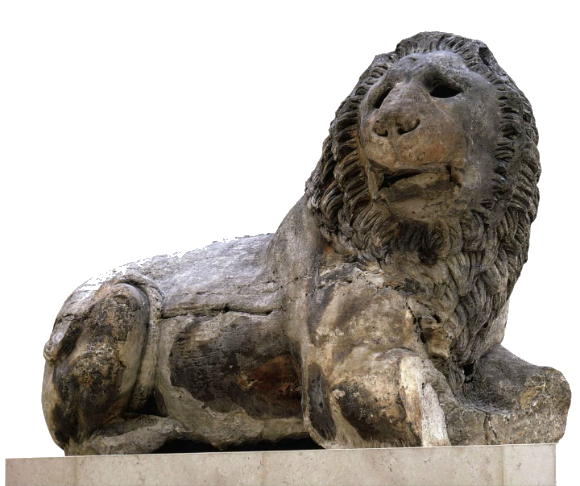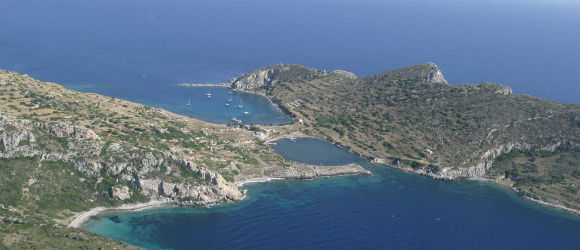The first location of Cnidus was half-way along the Datca peninsula. The residents moved it to its present site both on the Island of Tropium and on the mainland in about 365 B.C. The island is now connected to the mainland by a low, narrow isthmus which forms two small good harbors. Its citizens grew wealthy from commerce; the peninsula was famous for its wine. It was a center of culture: two theaters and an odeum suggest many hours of entertainment.
The city also had a good medical school. Praxiteles’ most famous statue, that of the nude Aphrodite, was bought by the city after the people of Cos rejected it in favor of a more modest and less celebrated woman. The original of the Cnidus statue is still being hunted; the best copy is in the Vatican Museum.
Ctesias, the Persian historian, was a native of Cnidus as was Sostratus, the builder of the Pharos at Alexandria. The Pharos was a lighthouse considered one of the Seven Wonders of the ancient world. Eudoxus, one of the great astronomers, was also born in Cnidus. He perhaps was the head of Plato’s Academy when Aristotle joined it in Plato’s absence in 367 B.C. Eudoxus had his own school later in Cyzicus. He made a map of the stars and invented the horizontal sun dial.
There were a number of temples in the city, among them ones to Dionysus and Aphrodite. Games were celebrated there in honor of Apollo and Poseidon. The agora, the Temple of Aphrodite, the odeum, and two theaters can be seen in the ruins, thanks to recent excavations.
Cnidus was the last landfall mentioned in Asia Minor in Paul’s journey from Jerusalem to Rome. He had been put on an Egyptian ship in Myra which sailed up the coast to Cnidus; because of headwinds they took a good many days to reach it (Acts 27:7). They probably did not anchor there because of the inclement weather which continued and in fact got much worse. Instead, they went on to Fair Havens in Crete where Paul advised them to winter, but, a southerly breeze springing up, the captain put out to sea again hoping for a better harbor. The wind changed and “for days on end there was no sign of either sun or stars, a great storm was raging, and our last hopes of coming through alive began to fade” (Acts 27:20).
They had run out of food before Paul saw a vision in which he was promised safe journey for himself and all on board. After two weeks they were shipwrecked, but all were saved: some swam to land, some paddled ashore on planks or parts of the broken ship. It was the island of Malta where they landed and then spent the winter. With better weather they continued on to Rome where according to tradition Paul immeasurably strenghtened the church, wrote some of his undying letters, was tried as an incendiary in the great fire during the reign of Nero, and was executed.

Knidos Lion “This colossal lion weighs some six tons. Made from one piece of marble, it was mounted on a base crowning a funerary monument. The monument itself was square with a circular interior chamber and a stepped-pyramid roof. It is a type of funerary monument inspired by the greater tomb of Maussollos, built about 350 BC”



We've visited a few historic sites in Turkey and all have been special in their own way. This was no exception. You can get there by boat but we wanted to take our time and not be restricted by a timetable so we drove from Mezgit (a pleasant 45 mins – well signposted). Beautiful route passing through villages where time…
This is an amazing Ancient Greek archaeological site. Its two amphiteatres suggests the scale of this ancient city. It's a real adventure to wander round the overgrown ruins (not the best maintained of sites, but that's sort of its charm) and the setting on the south-westernmost point of Turkey is magnificent. A must-see adventure for anyone visiting this part of…
We have visited these ruins several times and it is always a treat. The site is located at the extreme point of the Datca peninsula and the drive to reach it is breathtaking – in more ways than one!
The site is extensive and at various stages of excavation. Once at the site you have the choice of swimming in…
You travel 40km's to visit an ancient city established by the seaside. I don't advise you travel there at nook as it might be really hot and there are not too much shadows to have a rest.
We are true Datca fans by now. To me, Datca has the best sea among all Turkish coasts. Very peaceful, easy going, friendly and beautiful place. The place to detox your soul.
Knidos is off the beaten track but it offers a spectacular visit. Ruins are in a very large area. It's true that there is significant amount work needs to be done before it can come close to some othe sites but as it is you get the feeling how big this place was. What makes the place fabulous is the…
The Datca Peninsula in the south-west corner of western Turkey provides a natural boundary between the Aegean Sea, the Gulf of Gokova to the north and the Mediterranean Sea, the Gulf of Hisarnonu to the south. Knidos lies at the tip of this long finger of land projecting into the sea. It is not the easiest place to reach as…
Don't go there after 9 in the morning or before 6 in the evening, as we did. In the furnace-like heat of a July day the crumbled remains of something antique and once glorious are tremendously hard to enjoy.
There is nothing here except an Park Office and Cafe/Gift Shop. You are at the tip of the Seliyime Peninsula and walking among the Roman Ruins from at least 5th Century B.C..
At one time there were over 40,000 Romans living here.
Kindos is an ancient city, about 35 kilometres distance from Datca and at the end of the peninsula of the same name. The road from Datca is paved and reasonably maintained, making it suitable for all vehicles. The road for Knidos starts in Datca, to the right of the main highway and at the beginning of the town boundaries. Scenery…